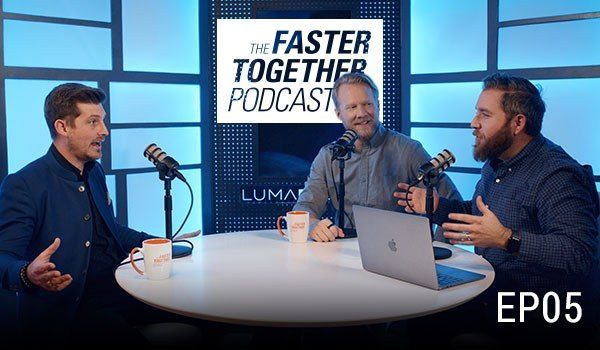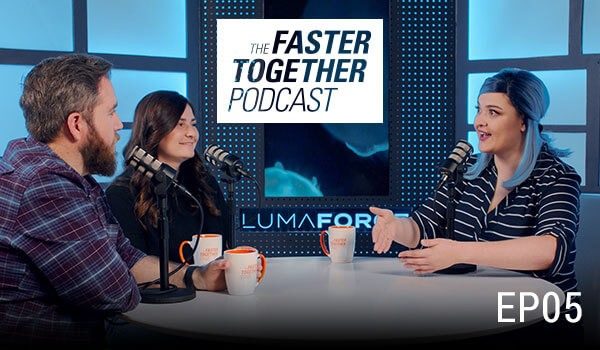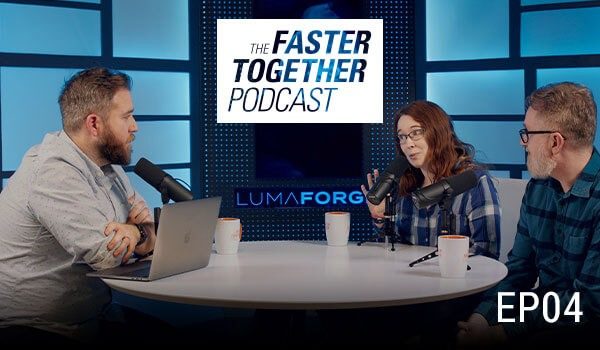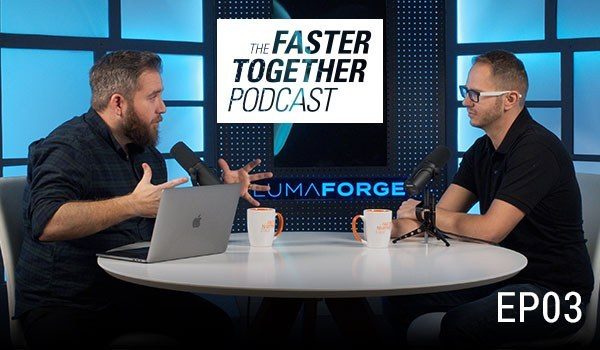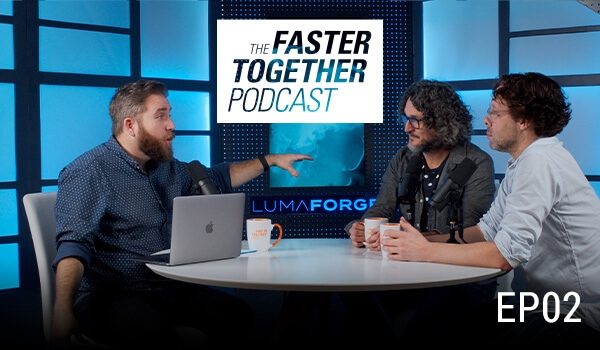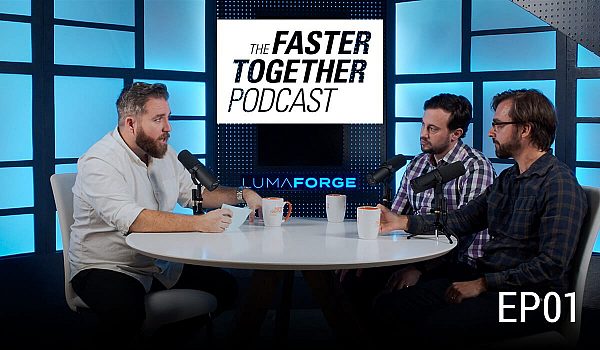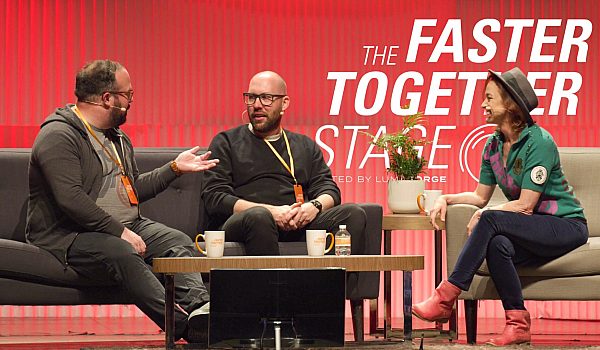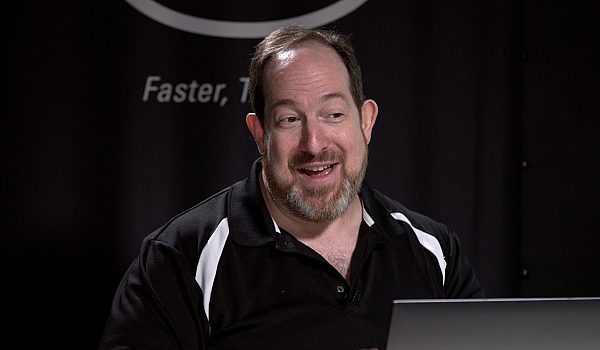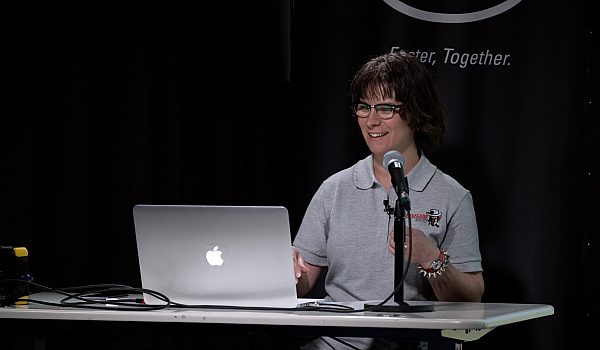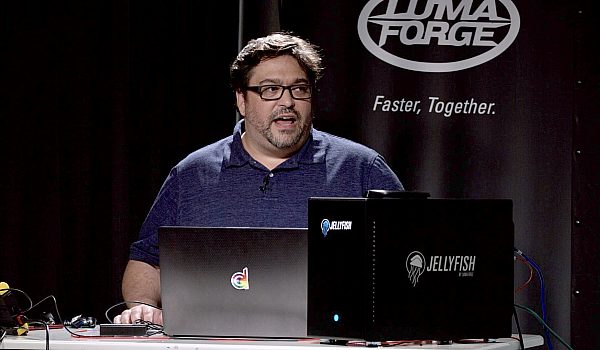The team behind the documentary 'The River & The Wall' discuss editing the feature-length project in DaVinci Resolve, color grading using Dolby Vision, and mixing the audio for Dolby Atmos. Enjoy this panel from The Faster Together Stage at NAB 2019.
Post production started in Adobe Premiere Pro CC, but moved to DaVinci Resolve when they discovered the speed at which Resolve could handle their multiple camera sources. Since the final color grade would happen in DaVinci Resolve, this made preparing for a Dolby Vision HDR color grade very easy. Otthouse Audio was then able to then mix the audio for the documentary for Dolby Atmos using ProTools.
- We are going to build the wall it will be a real wall. A real wall.
- Build that wall, build that wall, build that wall. This Rio Grande, that is Mexico, that is the United States, Texas and that is Mother nature's wall.
- [[Narrator] We are embarking on A 1200 mile journey to try and understand, where exactly a wall would go. Or what effects it would have.
- People are not thinking of this area when they're picturing the border wall.
- We got a real first hand perspective of what somebody would have to go through, if they were to cross illegally.
- When you live here, you see it differently, you feel it differently.
- We have to improve our understanding of an area that so many people talk about but many people have never been and don't understand.
- Hey guys.
- Hey.
- Hey
- How you guys doing tonight? Having fun so far? So we're here to talk about The River and the Wall and The River and the Wall is a feature length documentary that documents the journey of five friends, an ecologist, a river guide, two wildlife filmmakers, and a conservationist from El Paso to Boca Chica at the Gulf of Mexico, on bicycle, horseback, and canoe. And the whole idea here is, we're looking at the impact the border wall would have on environment, on culture, on private property, and of course immigration. So this was something that came up as a result of conversations while we we're doing wildlife films out in west Texas. I want to show you a little bit about what we're talking about here, so this is actually a 1200 mile journey, it's closer to go to Las Vegas than it is to go to the Gulf of Mexico. And they did this on their own power. So our team was Director Ben Masters, myself, the Sonic Architect Cheryl Ottenritter, Colorist extraordinaire Robbie Carman. So we knew from the get go, that we wanted to finish this film in 4K and in HD, because we wanted to do justice to some of these landscapes. Most people don't know what it is that we have out in west Texas. They think it's desert, they think that it's tumbleweeds, it's absolutely gorgeous, I encourage you to go, it is a magical place. So in the process of making the film, we shot on primarily three different cameras. So a Dragon 6K, a Helium that was generously lent to us from RED, and most of the very tame material, a Panasonic EVA1. For aerials, we typically used Inspire 2 with an X7 and with a lens package, and we generated about 400 hours of footage. That was a lot of fun to go through.
So we framed in 4K, yeah it was great, no really, as the editor, that was super. The whole idea, we focused on image quality, we knew that we wanted to do a HDR finish, we knew that we wanted to do an Atmos delivery because frankly we had an eye on delivering this to Netflix because it had the widest possible audience, to show people what it is that we're talking about, when we're talking about building a wall. Regardless of your political persuasion, we wanted to present to people, a very even handed look, at what a border wall would do. So in the initial editorial workflow, we're out in the field, we're dumping to your standard set of drives, two times, coming back into the edit room and dumping on to our Jellyfish, and writing to LTO two times, so that we got good achievable backups. Then we started importing that material into Premiere Pro and if you've spent time with a lot of RED footage, or a lot of cinema D and G footage in Premiere Pro, you know that, that preview generation, the waveform generation can take along time. And ours was no exception, we started to get very very nervous, because frankly we didn't think we we're going to be ready for edit. So we started to investigate alternatives and we settled on Resolve. We're a PC based shop, so Final Cut was not really in the equation. But Resolve was fitting the bill quite nicely for us. So the audio tools were terrific, because we had different discreet audio sources.
The metadata and the ability to search was actually terrific. And my primary experience as an editor comes from Final Cut so my comfort level was pretty high because a lot of Resolve maps to what we remember from Final Cut Pro. So we're an Indy Documentary, most of the time when you're doing that, that means you don't have the luxury of shared storage. But because we had a Jellyfish, we had multiple seats for my assistant, for an additional editor who was brought on and also for the director to come in and paper over all of my cuts and change everything that I did. so the primary editorial starts January, February of 2018 and last until just this January. Once everything is locked, we go from proxies to originals and basically conform there, in our facility before we ever hand it off for color. Audio is a slightly different story that Cheryl will--
- Just slightly.
- Just a little bit different--
- Just a little bit.
- As usual audio is the redheaded stepchild.
- Or blonde.
- Blonde, redheaded you take a beating.
- Yeah yeah.
- And so now Rob's going to tell us about what the workflow was like for the color handoff.
- Yeah, thanks John. So you see a lot of beautiful imagery going on here. And the first thing that attracted me to this film and one of the reasons that we ended up on Resolve was the idea that we went into it with the idea that we're not going to conform anything. And for any of you who don't know what that word means, that's the idea of basically moving and edit timeline to a finishing timeline. And we basically figured that saved us, not doing that conform process, saved us about four, five days of total time and--
- [John] Heartache.
- [Cheryl] Yeah.
- In that process four, five days when you're finishing is a lot of time and it's a lot of budget. All we did on our end was reassemble the reals that John provided us and got to grading right away on day number one. Audio still a little bit of an issue with--
- [Cheryl] Yeah.
- Some of the metadata that was from Resolve and stuff like that. But we eventually figured that out, but all in all saved a tremendous amount of time. As John said, when we started this process, talking about the film, we knew that we wanted to do it in HDR. But what flavor of HDR was another story and we talked about it, we ultimately decided that Dolby Vision was going to be the way to do it. And Dolby Vision is a system of course developed by Dolby, it's based on what's called PQ or the perception quantizer, you'll never remember that but that's what it's called. And the beauty about Dolby Vision is that it allows us to essentially grade once, deliver many. I can do an HDR grade and have utmost confidence that, that HDR grade would eventually translate to iPhones, iPads, SDR displays, other HDR displays that weren't reference monitors. And so you might be wondering, like how does Dolby Vision actually do that and it does that through a very sophisticated algorithms and what's known as tone mapping. So just real quick, if I was to grade something say at a 1000 Nits of luminance but my audience was looking at that on 650 Nits, like say their home HDR TV--
- Philistines.
- Yeah, I wouldn't want to just clip that information at the very top to match their 650 Nits display. It would look like junk. So instead what we do in an Dolby Vision workflow and the Dolby intelligent algorithms, is that we tone map. We're taking both luminance, as well as color volume, and mapping them to various target displays. I grade once, deliver many. So anywhere were that content is gonna show is important. And in this process that was really important because we had HDR deliverables, we knew that people were gonna be looking at this on SDR, we knew it was gonna be on the web, and so on. So if you just kind of visualize this for a second, if you don't have tone mapping in the HDR world, your beautiful HDR grade that you spent so much time one, can end up looking like junk if that tone mapping was not employed and that's one of the places where Dolby Vision really shines, because not only does it do this very well, it lets us as the artists, make creative decisions on a frame by frame or shot by shot basis, so we can get those down stream versions looking perfect. And so one of the first questions that we had when we started this process was like really guys this is a dock, are we sure we want to get this involved on a dock?
- Why can't we just do this regular SDRX over non. My opinion, Dolby Vision is a perfect fit for documentaries and we've seen a lot of growth, by offering these services because it allows independent film makers, perhaps you, and the projects you're working on to be able to go, hey Netflix, hey Amazon, hey Vudu, hey Hulu, we have something that's already mastered as Dolby Vision, we can do that really affordably and the big thing is this is available and tools right now. If you own DaVinci Resolve Studio, guess what, you have Dolby Vision. Which is pretty exciting for Projects of all sorts and sizes. And as I said, one of the cool things about Dolby Vision is managing a lot of deliverables. It used to be that I just grade and SDR version and there was one master file and that was it. Now I have a whole, huge long list of deliverables that I have to hit--
- [John] Hey that's not our fault.
- And Dolby Vision was able to make that happen from one master grade. And then finally like John said for us and the finishing in our facility shared storage really made this happen. I could be attacking the kind of creative look of the film, where on our other coast, Joanna could be following behind doing secondary work, doing Dolby Vision analysis, all because we're working off shared storage and our Jellyfish systems support shared databases from Resolve, and it was a really necessary thing in our workflow and we're really happy to make that happen-- [John] Oh god yes, absolutely.
- So Cheryl do you want to tell us a little about the audio workflow?
- Absolutely. Dolby Atmos is object based sound. And take everything you know about sound out okay. It's not channel based like right now we're listening to channel based audio. It is spacial, it's all around and it's projected from speakers and from your listening area. It's not traditional sound at all.
- It's the sonic lanscape.
- It is the sonic landscape.
- It really immerses you in the world.
- Exactly. The ability to build, especially for this film, I saw two frames of it and I was like this has got to be Dolby Atmos because of the textures that you can put in for the Atmos, ambiences, and all the nature. Because all the birds and everything else. Lets talk a little bit about do once, deliver many. It's almost the same thing with Dolby Atmos because you can deliver your traditional 7.1, 5.1, 2.0 your stereo, and then all your stems out of the Atmos, and it's all in one step. But let's just talk a minute about exactly what Atmos is. If you look at the diagram on your left, what makes Dolby Atmos so awesome is that they already thought through, how it's gonna get to you at home. How's it going to get to you at home. How are you going to listen to it in the big theater and then scale it back down to being at home.
- [Robbie] It's adaptable.
- It's totally adaptable and it's scaled to your listening environment. So I'm sitting in my suite and Robbie's yelling at me down the hallway, I'm sitting in my suite and I go okay well I'm gonna put that bird right there. Well guess what, in your home, because the projected metadata lives with the mix, it goes oh, in this living room, your setup with the up firing speakers on the left, you see the up firing speakers to the ceiling, oh that birds going to be right there. So it transfers all that information that spacial information with the mix. As a mixer it just makes me giddy. Because I don't have to worry anymore about whether your 5.1 speakers are on the floor or not. Now the diagram on the right is a more traditional home setup, where its an actual 7.1 so it has the left center right, the sides and the surrounds, and then it also has two sets of overheads. Actually in the wall. Excuse me on the ceiling. It's usually right on the ceiling or in the ceiling at home. I don't know about you but there's not too many people who really want to cut up their ceiling but that's why they have the up firing. This is when it gets to be fun. I love mixing in Atmos. It's so freeing. Now if you look at this, right on the left, I have my mixed up.
On the left, you have all the outputs, so you have your bed, your music, your sound effects, and it tells you what you're doing. Then you actually have the spacial layout. The physical layout of the speakers. And even though we don't pan traditionally, it helps gives us a sense of the sound field. But on the right, where you see the big green ball, that's where it's fun okay. So in this scene, our Ornithologist Heather, is walking through the forest. And when she's walking through the forest, the birds start to come out and they're everywhere. And they're calling to each other and as she walks through the forest, John had a great idea of having the bird stay, while she walks through to give that sense of actually walking through the environment, which is awesome. So let's take a listen, it's in a ballroom, you can't really listen but you'll get an idea. So then you can see how, okay there's the bird going across on the top, 'cause that's the z-axis the ceiling. And the larger feeling of ambience is right there with lots of birds okay they're all coming out and they're calling to each other and they're all really really doing a lot of work. This is just a small part of the reason why this doc, especially was perfect for Atmos because of all the animals and everything else. What I find in Atmos is that everybody thinks of 'em as like these big action movies with all the helicopters and the bombs and everything going off, for me Atmos, is much more intimate feeling, a much more intimate mix and especially with dialogue. And in this case, with all the friends on their journey, going down the river, in their kayaks and their horses, and their boats and everything else, it's following them along. You get to experience that journey, you're going through their space. You're living it. It's not 2D, you're in it.
- It really keeps the viewer in that suspension--
- And the story, right.
- Within the story, it really puts them there and it just makes the world come alive for the viewer.
- And Cheryl, like Dolby Vision, Atmos is really well fitted for the idea of multiple deliverables. I think we had at least 15 deliverables on the audio side for this project as well.
- Oh at least.
- And as you can see John was pretty stoked that from one master we're able to make all of this.
- Beyond excited.
- Right exactly, he was very excited.
- So here's the bottom line guys, every filmmaker in this room wants to get the most out of their project. Right, you want to have a project, where you go into it and go, I'ma have the best quality, best sounding audio, best sounding picture, it's possible right now with these tools right. The other thing is that for the past few years, you come to a show like anybody, and people are like, well this is a emerging technology, that's BS. It's here right now, you can do it, everybody and every budget can do this high end workflow with Dolby Vision, Dolby Atmos on their next project.
- I mean we're an independent documentary. You don't get any more bottom of the barrel right.
- Absolutely.
- At the end of the day I feel like passionate that by offering independent productions, especially docs, the ability to jump into Vision and Atmos projects, HDR and immersive audio, you're much more attractive to the wide range of distributors and buyers out there because you're doing those things. And that's one of the things that we definitely focused on.
- Yeah, it elevates your quality in a way that just hasn't been accessible for people like me.
- Yeah. It just hasn't been accessible.
- And in while it might seem things like monitors and some of the gear that's associated with it is expensive and that's not untrue. Getting started with it and getting your feet wet and learning the workflows and trying it on your next project is possible and really these technologies, allow you to really get your creative vision down in a way that's never been done before. So John tell us where people can learn more about this film.
- So the River and the Wall will be released theatrically May 3rd, roughly 200 theaters across the country. It'll also be on streaming platforms like iTunes and Amazon, et cetera on that same day. If you cannot see it on the big screen and it is a film that is worthy of seeing it on the big screen, I would highly recommend that you seek it out in HDR and Atmos home environment because it's stunning. They did fabulous work.
- Now if all those Dolby Vision stuff and Atmos Stuff is like what are we talking about, don't worry. Dolby actually has some pre training that was actually just released last week and I was lucky to be apart of it, along with my partner Joey D'Anna doing the Vision side. But there's also some free training about Dolby Atmos as well. Really get you up to speed with that stuff real quick. As a shameless plug, if you need help with this stuff, Cheryl and I with our different companies, DC Color and Ott House Audio, can also help you with that as well, and finally thank you so much to the team LumaForge for having us here, we really appreciate it.
- Yeah.
- Thank you.
- Hope everybody enjoys the rest of the NAB and thank you very much!
- Enjoy!
- Thanks guys.
- Thank you.
- Alright, thank you.


 Mobile
Mobile
 Tower
Tower
 R24
R24
 Builder
Builder
 Manager
Manager
 Connect
Connect
 Kyno
Kyno
 Media Engine
Media Engine
 Remote Access
Remote Access
 Support
Support
